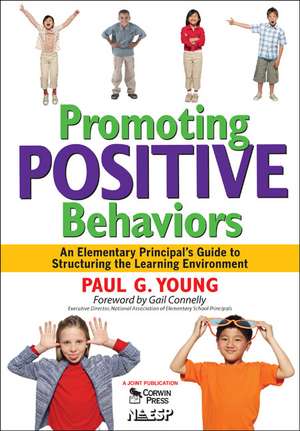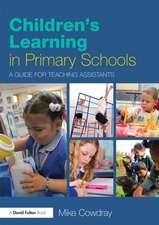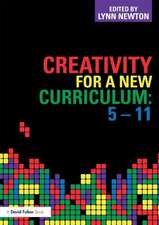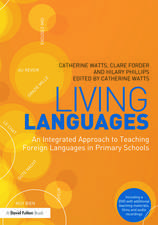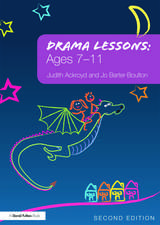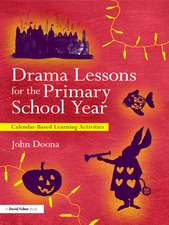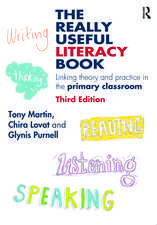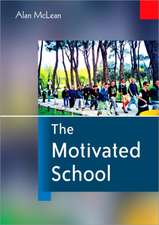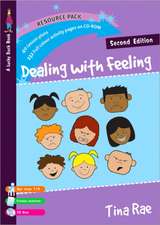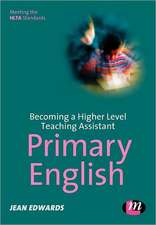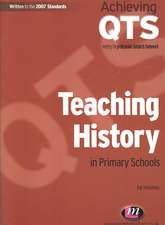Promoting Positive Behaviors: An Elementary Principal’s Guide to Structuring the Learning Environment
Autor Paul G. Youngen Limba Engleză Paperback – 11 feb 2008
- Supervising the morning playground -Communicating expectations to students -Using student incentives and recognitions -Building relationships with parents -Establishing a student council, and more
| Toate formatele și edițiile | Preț | Express |
|---|---|---|
| Paperback (1) | 217.67 lei 6-8 săpt. | |
| SAGE Publications – 11 feb 2008 | 217.67 lei 6-8 săpt. | |
| Hardback (1) | 442.72 lei 6-8 săpt. | |
| SAGE Publications – 4 feb 2008 | 442.72 lei 6-8 săpt. |
Preț: 217.67 lei
Nou
Puncte Express: 327
Preț estimativ în valută:
41.65€ • 42.97$ • 34.76£
41.65€ • 42.97$ • 34.76£
Carte tipărită la comandă
Livrare economică 26 martie-09 aprilie
Preluare comenzi: 021 569.72.76
Specificații
ISBN-13: 9781412953047
ISBN-10: 1412953049
Pagini: 136
Dimensiuni: 178 x 254 x 8 mm
Greutate: 0.29 kg
Ediția:1
Editura: SAGE Publications
Colecția Corwin
Locul publicării:Thousand Oaks, United States
ISBN-10: 1412953049
Pagini: 136
Dimensiuni: 178 x 254 x 8 mm
Greutate: 0.29 kg
Ediția:1
Editura: SAGE Publications
Colecția Corwin
Locul publicării:Thousand Oaks, United States
Recenzii
"Paul Young identifies key elements of school structure that every principal and staff must have in place before strides in student achievement and parent engagement can be fully realized."
"Young shares practical ideas that can be implemented in rural, suburban, or urban schools to impact school climate, staff morale, and student achievement. This volume should be in every elementary school principal’s professional library."
"This book addresses the many benefits of a well-structured school and provides educators with valuable lessons to identify, understand, and capitalize on their strengths to positively shape school structure and improve teaching and learning."
"Offers examples from the author's experience as a successful elementary school principal and tips for overall school and student management."
"Young shares practical ideas that can be implemented in rural, suburban, or urban schools to impact school climate, staff morale, and student achievement. This volume should be in every elementary school principal’s professional library."
"This book addresses the many benefits of a well-structured school and provides educators with valuable lessons to identify, understand, and capitalize on their strengths to positively shape school structure and improve teaching and learning."
"Offers examples from the author's experience as a successful elementary school principal and tips for overall school and student management."
Cuprins
Forward by Gail Connelly, Executive Director of NAESP
Acknowledgments
About the Author
Introduction
Purpose of This Book
Overview of the Contents
1. Beginnings: The Day and the Year
Introduction
Plan for Effective Morning Playground Supervision
Allow Recess in the Morning
Form a Safety Patrol
Teach Expectations to Students While Lining Up After the Bell Sounds
Build Relationships With Parents
Teach Children to Move Quietly Through the Hallways
Lock the Doors
Structure Homeroom Activities
Provide Universal Breakfast in the Classroom
Make Morning Accouncements
Check Bookbags and Homework Planners
Do the Shirts and the Pants Touch?
No Talking During Emergency Drills
Establish a Student Council
Establish Student Incentives and Recognitions
Empower Staff to Develop Schedules
Learn All Students' Names
Establish an Effective Intervention Assistance Process
Structure Effective Meetings
Check Mail and Messages at Least Three Times Daily
Establish the Schedule and Goals for the Day
Concluding Thoughts
Explanation of the Structural Analysis & Assessment Checklists
Checklist #1: Beginnings: Structural Analysis and Assessment
2. Early Focus on Learning and Instruction
Introduction
Escort Students to and From Special Classes
Establish Procedures for Restroom Breaks
Practice Entering and Leaving Assemblies
Develop a Substitute Handbook
Time on Task
Establish Inclusion Practices
Establish Procedures for Referring Students to the Office
Fully Utilize Volunteer Services
Teach a Code of Conduct
Common, Grade-Level Planning Increases Student Achievement
Concluding Thoughts
Checklist #2: Learning and Instruction: Structural Analysis and Assessment
3. Midpoints of the Day or Year
Introduction
Equip Yourself for Playground Supervision
Teach Manners and Hygiene
Facilitate Efficient Food Serving Lines
Schedule Recess First, Eat Afterwards
Speak With Inside Voices
Practice Forming Lines
Structure Playground Games
Monitor Students' Behavior and Eating Habits
Establish Procedures for Indoor Recess Supervision
Take Pictures and Use Recorders
Establish Contingency Plans for Crisis Supervision
Teach Children to Speak in Complete Sentences
Develop a Conflict Mediation Program
Concluding Thoughts
Checklist #3: Midpoints: Structural Analysis and Assessment
4. The Second Half of the Day or Year
Introduction
Reading Can Be Taught After Lunch
Create an "Adam Plan"
Supervise Student Suspensions
Write Notes and Return Phone Calls
Teach Multiple Intelligences
Show Evidence of Student Learning
Allow Children to Draw
Serve Fruit and Vegetable Afternoon Snacks
Don't Get Tired and Let Down Your Guard
Give Attention to Customer Service
Eliminate Loitering in the Hallways and Office
Utilize Homework Planners
Communicate With Parents
Concluding Thoughts
Checklist #4: The Second Half: Structural Analysis and Assessment
5. Endings: Dismissal and Wrap-up of the Year
Introduction
Monitor Bus Pickup and Drop-Off Locations
Ride School Buses
Delineate Walking Students From Parent Pickups, Bus Riders, and Others
Walk Students Home
Share Positives With Parents
How Effective are Detentions?
Eliminate Clutter Throughout the Campus
Establish Curb Appeal
Eliminate Gum
Prepare the Classroom for Custodian Cleaning
Establish Procedures for Determining Student Classroom Placements
Reflect and Take Action on Important Issues
Be a Master Motivator
Coordinate Learning Opportunities With the Afterschool Program
Concluding Thoughts
Checklist #5: Endings Dismissal and Wrap-up of the Year: Structural Analysis and Assessment
Summary Comments
Recommended Readings
Index
Acknowledgments
About the Author
Introduction
Purpose of This Book
Overview of the Contents
1. Beginnings: The Day and the Year
Introduction
Plan for Effective Morning Playground Supervision
Allow Recess in the Morning
Form a Safety Patrol
Teach Expectations to Students While Lining Up After the Bell Sounds
Build Relationships With Parents
Teach Children to Move Quietly Through the Hallways
Lock the Doors
Structure Homeroom Activities
Provide Universal Breakfast in the Classroom
Make Morning Accouncements
Check Bookbags and Homework Planners
Do the Shirts and the Pants Touch?
No Talking During Emergency Drills
Establish a Student Council
Establish Student Incentives and Recognitions
Empower Staff to Develop Schedules
Learn All Students' Names
Establish an Effective Intervention Assistance Process
Structure Effective Meetings
Check Mail and Messages at Least Three Times Daily
Establish the Schedule and Goals for the Day
Concluding Thoughts
Explanation of the Structural Analysis & Assessment Checklists
Checklist #1: Beginnings: Structural Analysis and Assessment
2. Early Focus on Learning and Instruction
Introduction
Escort Students to and From Special Classes
Establish Procedures for Restroom Breaks
Practice Entering and Leaving Assemblies
Develop a Substitute Handbook
Time on Task
Establish Inclusion Practices
Establish Procedures for Referring Students to the Office
Fully Utilize Volunteer Services
Teach a Code of Conduct
Common, Grade-Level Planning Increases Student Achievement
Concluding Thoughts
Checklist #2: Learning and Instruction: Structural Analysis and Assessment
3. Midpoints of the Day or Year
Introduction
Equip Yourself for Playground Supervision
Teach Manners and Hygiene
Facilitate Efficient Food Serving Lines
Schedule Recess First, Eat Afterwards
Speak With Inside Voices
Practice Forming Lines
Structure Playground Games
Monitor Students' Behavior and Eating Habits
Establish Procedures for Indoor Recess Supervision
Take Pictures and Use Recorders
Establish Contingency Plans for Crisis Supervision
Teach Children to Speak in Complete Sentences
Develop a Conflict Mediation Program
Concluding Thoughts
Checklist #3: Midpoints: Structural Analysis and Assessment
4. The Second Half of the Day or Year
Introduction
Reading Can Be Taught After Lunch
Create an "Adam Plan"
Supervise Student Suspensions
Write Notes and Return Phone Calls
Teach Multiple Intelligences
Show Evidence of Student Learning
Allow Children to Draw
Serve Fruit and Vegetable Afternoon Snacks
Don't Get Tired and Let Down Your Guard
Give Attention to Customer Service
Eliminate Loitering in the Hallways and Office
Utilize Homework Planners
Communicate With Parents
Concluding Thoughts
Checklist #4: The Second Half: Structural Analysis and Assessment
5. Endings: Dismissal and Wrap-up of the Year
Introduction
Monitor Bus Pickup and Drop-Off Locations
Ride School Buses
Delineate Walking Students From Parent Pickups, Bus Riders, and Others
Walk Students Home
Share Positives With Parents
How Effective are Detentions?
Eliminate Clutter Throughout the Campus
Establish Curb Appeal
Eliminate Gum
Prepare the Classroom for Custodian Cleaning
Establish Procedures for Determining Student Classroom Placements
Reflect and Take Action on Important Issues
Be a Master Motivator
Coordinate Learning Opportunities With the Afterschool Program
Concluding Thoughts
Checklist #5: Endings Dismissal and Wrap-up of the Year: Structural Analysis and Assessment
Summary Comments
Recommended Readings
Index
Notă biografică
Paul Young, PhD, a retired elementary principal, is currently the Executive Director of the West After School Center in Lancaster, Ohio. He began his career as a high school band director and then retrained to become a fourth grade teacher before advancing to an elementary principalship in 1986.
He served as President of the Ohio Association of Elementary School Administrators (OAESA) in 1997 and was elected to the National Association of Elementary School Principals (NAESP) Board of Directors in 1998 (the only person elected by write-in ballot). He became president-elect in 2001-2002 and served as the national president during the 2002-2003 school year. He retired in December 2004. Since retirement, he has served as an advocate for the advancement of equitable and affordable afterschool programming for all children.
Dr. Young completed a Bachelor of Fine Arts degree in music education in 1972 and a Master of Music degree in trombone performance in 1973, both from Ohio University-Athens. He earned a PhD in educational administration from OU in 1992. Young has taught undergraduate music classes at Ohio University-Lancaster for more than 25 years. He continues to teach private trombone lessons. He is a strong advocate for the arts. He is the past president of the Ohio University School of Music Society of Alumni and Friends.
Dr. Young is the author of Mastering the Art of Mentoring Principals, You Have to Go to School, Yoüre the Principal: 101 Tips to Make it Better for Your Students, Your Staff, and Yourself and Mentoring Principals: Frameworks, Agendas, Tips, and Case Studies for Mentors and Mentees. He has also written numerous articles about music, the arts, student management, and the principalship for professional journals.
He served as President of the Ohio Association of Elementary School Administrators (OAESA) in 1997 and was elected to the National Association of Elementary School Principals (NAESP) Board of Directors in 1998 (the only person elected by write-in ballot). He became president-elect in 2001-2002 and served as the national president during the 2002-2003 school year. He retired in December 2004. Since retirement, he has served as an advocate for the advancement of equitable and affordable afterschool programming for all children.
Dr. Young completed a Bachelor of Fine Arts degree in music education in 1972 and a Master of Music degree in trombone performance in 1973, both from Ohio University-Athens. He earned a PhD in educational administration from OU in 1992. Young has taught undergraduate music classes at Ohio University-Lancaster for more than 25 years. He continues to teach private trombone lessons. He is a strong advocate for the arts. He is the past president of the Ohio University School of Music Society of Alumni and Friends.
Dr. Young is the author of Mastering the Art of Mentoring Principals, You Have to Go to School, Yoüre the Principal: 101 Tips to Make it Better for Your Students, Your Staff, and Yourself and Mentoring Principals: Frameworks, Agendas, Tips, and Case Studies for Mentors and Mentees. He has also written numerous articles about music, the arts, student management, and the principalship for professional journals.
Descriere
This practical handbook helps educators create processes that communicate expectations, promote positive student behaviors, reduce schoolwide management problems, build relationships with parents, and increase student achievement.
